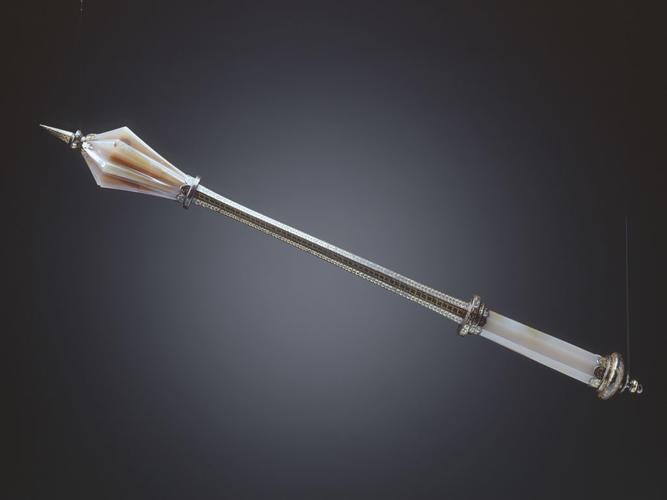Horseman's parade mace fifteenth century?
Agate head and handle; iron shaft overlaid with gold | 53.0 x 5.0 x 5.0 cm (whole object) | RCIN 67259
-
Maces for use in battle were made in this form in Europe from the earliest times, with varying degrees of ornamentation. The 'flanged' head of the kind seen here first appeared in the fourteenth century, but was rare before the fifteenth. In this instance both the head and the grip are made of agate, a semi-precious stone used to an extent which clearly denotes a ceremonial or parade weapon. The haft (stem) was probably also originally of agate, replaced at some early date in russeted iron, overlaid with gold.
Other maces carved from semi-precious stones are in the Kunsthistorisches Museum, Vienna, and in Munich, Modena and Brussels. A comparable mace in the Kunstgewerbemuseum, Berlin was traditionally called the 'Sceptre of Charlemagne'. The present example has also been mistaken for a sceptre, that is a staff or baton borne as an emblem of kingship. Perhaps because of its small - but not exceptional - size, it has been associated with Elizabeth Stuart, Queen of Bohemia (1596-1662), the 'Winter Queen', and was thought to have been included in the bequest to her protector, William, Earl of Craven (1606-97). However, no trace of such a sceptre or mace has been found either in the Queen's will or in that of Lord Craven.
Catalogue entry from Royal Treasures, A Golden Jubilee Celebration, London 2002Provenance
Thought to have been left by Elizabeth Queen of Bohemia to William, Lord Craven & descended from him to Keppel family. By descent to the ninth Earl of Albermarle; by whom presented to Her Majesty Queen Elizabeth II in 1978.
-
Medium and techniques
Agate head and handle; iron shaft overlaid with gold
Measurements
53.0 x 5.0 x 5.0 cm (whole object)








